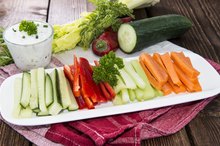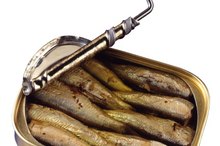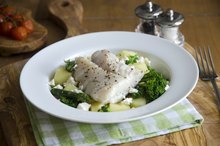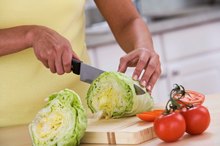What does fact checked mean?
At Healthfully, we strive to deliver objective content that is accurate and up-to-date. Our team periodically reviews articles in order to ensure content quality. The sources cited below consist of evidence from peer-reviewed journals, prominent medical organizations, academic associations, and government data.
- Centers for Disease Control and Prevention: Protein
- Centers for Disease Control and Prevention: Iron and Iron Deficiency
The information contained on this site is for informational purposes only, and should not be used as a substitute for the advice of a professional health care provider. Please check with the appropriate physician regarding health questions and concerns. Although we strive to deliver accurate and up-to-date information, no guarantee to that effect is made.
Littleneck Clams Nutrition
Littleneck clams are the smallest of clams, and usually are the most sought after, according to the website SeafoodHealthFacts.org 1. Littleneck clams are grown on the Pacific coast, and like other clams, they are low in fat and are a good source of protein. Knowing the nutrition facts for littleneck clams can help you learn how they fit into your healthy diet.
Low-Calorie Choice
If you're watching your caloric intake, littleneck clams make a good choice, with 130 calories in a 3-ounce, cooked portion. By comparison, the same portion of cooked white meat chicken contains 140 calories. Most Americans already eat more calories than they need, according to the 2010 Dietary Guidelines for Americans, and finding ways to cut calories here and there can help you get to or maintain a healthier weight.
- If you're watching your caloric intake, littleneck clams make a good choice, with 130 calories in a 3-ounce, cooked portion.
- Most Americans already eat more calories than they need, according to the 2010 Dietary Guidelines for Americans, and finding ways to cut calories here and there can help you get to or maintain a healthier weight.
High-Quality Protein
Nutritional Facts for Canned Crab Meat
Learn More
With 22 grams of protein in a 3-ounce portion, littleneck clams are a good source of protein. Protein needs vary, depending on age and gender, but most women need 46 grams of protein a day, and men need 56 grams a day. One serving meets 40 percent or more of your daily protein needs. Additionally, as an animal source of protein, littleneck clams contain all of the essential amino acids, which means that they are a high-quality source of protein.
- With 22 grams of protein in a 3-ounce portion, littleneck clams are a good source of protein.
- Additionally, as an animal source of protein, littleneck clams contain all of the essential amino acids, which means that they are a high-quality source of protein.
Low in Fat
Littleneck clams are also very low in fat; in fact, they are lower in fat than white-meat chicken and contain no saturated fat. A 3-ounce portion of the cooked clams contains just 2 grams of total fat. Consuming an excessive amount of fat and saturated fat increases your risk of heart disease, says the 2010 Dietary Guidelines for Americans 3. To reduce your risk, limit your intake of total fat to 20 to 35 percent of calories, and your total intake of saturated fat to less than 10 percent of calories. Littleneck clams can help you limit your total fat and saturated fat intake.
- Littleneck clams are also very low in fat; in fact, they are lower in fat than white-meat chicken and contain no saturated fat.
- Littleneck clams can help you limit your total fat and saturated fat intake.
Sodium and Potassium
Calories in Steamed Clams
Learn More
Littleneck clams are a natural source of sodium, but they also provide potassium. A 3-ounce portion contains 95 milligrams of sodium and 530 milligrams of potassium. A high intake of sodium increases blood pressure, and you should limit your daily intake to less than 2,300 milligrams, or less than 1,500 milligrams, if you already have high blood pressure. Potassium in food, however, decreases the effects of sodium on blood pressure, says the 2010 Dietary Guidelines for Americans. You should aim for 4,700 milligrams of potassium a day.
- Littleneck clams are a natural source of sodium, but they also provide potassium.
- A high intake of sodium increases blood pressure, and you should limit your daily intake to less than 2,300 milligrams, or less than 1,500 milligrams, if you already have high blood pressure.
Vitamins and Minerals
Littleneck clams are a good source of vitamins A and C, and also of iron, with 10, 30 and 130 percent of the daily value, respectively, in a 3-ounce portion. The clams can also help you meet your daily calcium needs. Vitamin A is a fat-soluble vitamin that is important for eye sight and immune health. Water-soluble vitamin C improves your body's ability to fight off infection, and also assists with the healing of cuts. Iron carries oxygen from your lungs to the rest of your body, and not getting enough in your diet can lead to anemia.
- Littleneck clams are a good source of vitamins A and C, and also of iron, with 10, 30 and 130 percent of the daily value, respectively, in a 3-ounce portion.
- Iron carries oxygen from your lungs to the rest of your body, and not getting enough in your diet can lead to anemia.
Related Articles
References
- SeafoodHealthFacts.org: Seafood Choices: Clams
- U.S. Department of Agriculture: National Nutrient Database for Standard Reference: Chicken, Broilers or Fryers, Breast, Meat Only, Roasted
- U.S. Department of Agriculture & U.S. Department of Health and Human Services: Dietary Guidelines for Americans, 2010
- KidsHealth: Vitamins
Writer Bio
Jill Corleone is a registered dietitian and health coach who has been writing and lecturing on diet and health for more than 15 years. Her work has been featured on the Huffington Post, Diabetes Self-Management and in the book "Noninvasive Mechanical Ventilation," edited by John R. Bach, M.D. Corleone holds a Bachelor of Science in nutrition.









